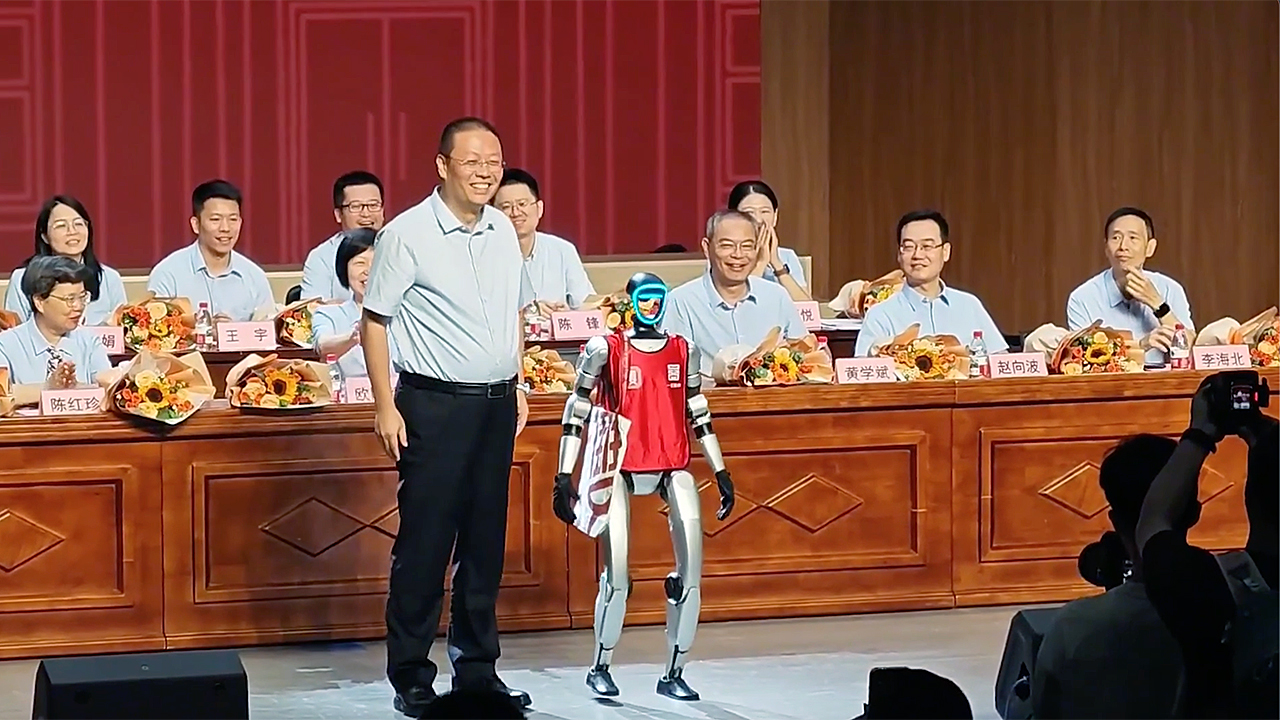A Glimpse into the Future: Humanoid Robot “Graduates” at Chinese High School Ceremony

A Historic Moment in Education and Robotics
In a groundbreaking and symbolic moment, a humanoid robot named “Shuang Shuang” participated in a high school graduation ceremony in China, capturing the imagination of tech enthusiasts, educators, and futurists around the globe. The event, held at a prestigious high school in the eastern province of Jiangsu, marked one of the first public appearances of a humanoid robot taking part in a formal education milestone.
As “Shuang Shuang” walked across the stage, bowed, and received a graduation certificate just like her human peers, the audience erupted in applause—half in awe, half in disbelief. It was a strong visual statement: the line between artificial intelligence and human life continues to blur.
What Makes “Shuang Shuang” Unique?
Developed by a team of Chinese AI researchers and robotics engineers, Shuang Shuang is more than just a machine in a uniform. The robot features:
-
Human-like facial expressions and responsive gestures
-
Natural language processing abilities for conversation
-
Autonomous mobility for walking, standing, and performing gestures
-
A built-in emotion detection system that allows it to react contextually
The robot was integrated into the school environment for over six months, where it interacted with students, answered basic academic questions, and participated in extracurricular activities. According to the school principal, “Shuang Shuang became a part of the student body in both function and spirit.”
Why This Matters: Symbolism vs. Reality
While the robot did not actually earn academic credits or sit for exams, its inclusion in the ceremony was highly symbolic. It showcased China’s ambition to lead the world in robotics and AI integration, particularly in education, healthcare, and public services.
This stunt also raises a question:
Are we ready for robots to be part of our daily human milestones?
It also subtly addresses society’s readiness to accept AI not just as a tool, but as a companion in schools, hospitals, and eventually, households.
The Bigger Picture: China’s Race Toward AI Leadership
Over the last decade, China has emerged as a global frontrunner in the artificial intelligence (AI) and robotics race, aiming to become the world’s AI superpower by 2030. The appearance of a humanoid robot like Shuang Shuang at a high school graduation is not just a fascinating spectacle—it reflects a strategic, government-backed push to normalize and embed AI across every layer of Chinese society.
National Policy Backing
China’s central government has made AI development a national priority. In 2017, the country announced its “Next Generation Artificial Intelligence Development Plan”, a blueprint to build a $150 billion AI industry by 2030. Since then, the government has:
-
Invested billions in AI research hubs across cities like Beijing, Shanghai, and Shenzhen.
-
Offered incentives to AI startups, robotics firms, and university research labs.
-
Partnered with private tech giants like Baidu, Alibaba, Huawei, and Tencent to accelerate AI innovation.
These efforts have created a robust AI ecosystem that combines academic knowledge, private sector speed, and state-level coordination—a model unmatched in many parts of the world.
Focus on Human-AI Integration
Unlike many countries that view AI with caution, China is actively promoting AI as a social and educational asset. Robots are being developed not just for manufacturing or logistics, but for daily life—from robotic teaching assistants and elderly caregivers to hospital receptionists and smart city infrastructure managers.
Shuang Shuang’s inclusion in a graduation ceremony is a symbol of AI integration into human culture. China wants its citizens—especially the youth—to grow up in a world where interacting with machines feels as natural as interacting with people.
AI in Education, Healthcare, and Public Services
China is already deploying AI at scale in:
-
Education: Smart classrooms use facial recognition to track student engagement; AI tutors provide personalized learning paths.
-
Healthcare: AI is used for early diagnosis, robotic surgeries, and pandemic response.
-
Law & Governance: AI helps streamline court case processing, traffic monitoring, and citizen service chatbots.
By placing robots in emotionally significant roles—like that of a “graduating student”—China is shaping public perception and paving the way for widespread acceptance of intelligent machines.
Global Implications
China’s aggressive push in AI leadership raises critical questions for the rest of the world:
-
Will other countries keep pace or fall behind in integrating AI into public life?
-
What ethical boundaries should be considered as robots take part in human traditions?
-
Could this lead to an imbalance in global tech dominance if regulation and innovation remain uneven?
While Western nations focus heavily on regulation and ethical debates, China is accelerating deployment and public integration—giving it a significant first-mover advantage.
A Vision for the Future
China’s vision is clear: AI is not just a tool—it’s a partner in building a smarter, more efficient, and more advanced society. Whether it’s a robot helping students or managing traffic lights, China is laying the groundwork for an AI-augmented civilization.
Shuang Shuang walking across that graduation stage is not just a quirky headline—it’s a symbolic milestone in China’s journey to lead the wo
Final Thoughts
The image of a humanoid robot in a graduation gown receiving a certificate may seem surreal today. But just like smartphones and self-driving cars, this moment might become ordinary sooner than we think.
This isn’t just the story of a robot “graduating.”
It’s a signpost pointing toward the future of education, companionship, and what it means to be ‘present’ in a digital age.







